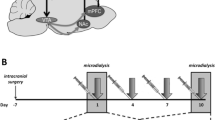Abstract
The central nervous system stimulants corticotropin releasing factor (CRF) and amphetamine were administered in combination with the benzodiazepine ligands Ro 15-1788 and FG 7142 in order to assess their benzodiazepine agonist and antagonist receptor properties in an operant conflict test in rats. Ro 15-1788, which was without behavioral activity in this test when given alone, reversed the suppression of punished responding produced by CRF and amphetamine in a dose-dependent manner. Chlordiazepoxide, which produced a release of punished responding by itself, also reversed the suppression of punished responding produced by CRF but not that of amphetamine. The benzodiazepine inverse agonist FG 7142, in contrast, enhanced the rate suppressing actions of both CRF and amphetamine. In a locomotor activity test, Ro 15-1788 failed to block the locomotor activation observed with CRF and amphetamine. The results suggest that “anxiety” or stress-enhancing compounds may enhance the partial agonist properties of Ro 15-1788 in certain test situations.
Similar content being viewed by others
References
Antelman SM, Eichler AJ, Black CA, Kocan D (1980) Interchangeability between stress and amphetamine in sensitization. Science 207:329–331
Bonetti EP, Pieri L, Cumin R, Schaffner R, Pieri M, Gamzu ER, Muller RK, Haefely W (1982) Benzodiazepine antagonist Ro 15–1788: Neurological and behavioral effects. Psychopharmacology 78:8–18
Britton KT, Koob GF (1986) Alcohol reverses the proconflict effects of corticotropin releasing factor. Regul Pept 16:315–320
Britton KT, Morgan J, Rivier J, Vale W, Koob GF (1985) Chlordiazepoxide attenuates response suppression induced by corticotropin releasing factor in the conflict test. Psychopharmacology 86:170–174
Britton KT, Ehlers CE, Koob GF (1987) Ethanol antagonist, RO 15-4513, is not selective for ethanol. Science (in press)
Cook L, Sepinwall J (1975) Behavioral analysis of the effects and mechanism of action of benzodiazepines. In: Costa E, Greengard P (eds) Mechanisms of action of benzodiazepines. Raven Press, New York, pp 1–28
Corda MG, Blaker WD, Mendelson WB, Guidotti A, Costa E (1983) β-carbolines enhance shock-induced suppression of drinking in rats. Proc Natl Acad Sci USA 80:2072–2076
Dantzer R, Perio A (1982) Behavioral evidence for partial agonist properties of Ro 15–1788, a benzodiazepine receptor antagonist. Eur J Pharmacol 81:55–58
De Vry J, Slangen JL (1985) Stimulus control induced by benzodiazepine antagonist Ro 15–1788 in the rat. Psychopharmacology 85:483–485
De Vry J, Slangen JL (1986) Effects of chlordiazepoxide training dose on the mixed agonist-antagonist properties of benzodiazepine receptor antagonist Ro 15–1788 in a drug discrimination procedure. Psychopharmacology 88:177–183
Dorow R, Horowski R, Paschelke G, Amin M, Braestrup C (1983) Severe anxiety induced by FG 7142, a beta-carboline ligand for benzodiazepine receptors. Lancet II:98–99
Ehlers CL, Hendricksen SJ, Wang M, Rivier J, Vale WW, Bloom FE (1983) Corticotropin releasing factor produces increases in brain excitability and convulsive seizures in the rat. Brain Res 278:332–336
File SE, Lister RG, Nutt DJ (1982) The anxiogenic action of benzodiazepine antagonists. Neuropharmacology 21:1033–1037
File SE, Pellow S (1984) The anxiogenic action of Ro 15–1788 is reversed by chronic, but not acute, treatment with chlordiazepoxide. Brain Res 310:154–156
File SE, Pellow S (1986) Intrinsic actions of the benzodiazepine receptor antagonist Ro 15–1788. Psychopharmacology 88:1–11
Geller I, Seifter J (1960) The effect of meprobamate, barbiturates, d-amphetamine and promazine on experimentally-induced conflict in the rat. Psychopharmacologi 1:482–491
Grecksch G, de Carvalho LP, Venault P, Chapouthier G, Rossier J (1983) Convulsions induced by submaximal dose of pentylene tetrazol in mice are antagonized by the benzodiazepine antagonist Ro 15–1788. Life Sci 32:2579–2584
Hoffman DK, Britton DR (1983) Anxiogenic-like properties of benzodiazepine antagonists. Neurosci Abstr 9:129
Hunkeler W, Mohler H, Pieri L, Polc P, Bonetti EP, Cumin R, Schaffner R, Haefely W (1981) Selective antagonists of benzodiazepines. Nature 290:514–516
Jensen LH, Petersen EN, Braestrup C (1983) Audiogenic seizures in DBA/2 mice discriminate sensitively between low efficacy benzodiazepine receptor agonists and inverse agonists. Life Sci 33:393–399
Jensen LH, Petersen EN, Braestrup C, Honore T, Kehr W, Stephens DN, Schneider H, Seidelmann D, Schmiechen R (1984) Evaluation of the β-carboline ZK 93 426 as a benzodiazepine receptor antagonist. Psychopharmacology 83:243–256
Koob GF, Braestrup C, Thatcher-Britton K (1986) The effects of FG 7142 and RO 15–1788 on the release of punished responding produced by chlordiazepoxide and ethanol in the rat. Psychopharmacology 90:173–178
Liljequist S, Engle JA (1984) Reversal of the anti conflict action of valproate by various GABA and benzodiazepine antagonists. Life Sci 34:2525–2533
Mohler H, Burkard WP, Keller HH, Richards JG, Haefely W (1981) Benzodiazepine antagonist Ro 15–1788: Binding characteristics and interaction with drug-induced changes in dopamine turnover and cerebellar cGMP levels. J Neurochem 37:714–722
Mohler H, Richards JG (1981) Agonist and antagonist benzodiazepine receptor interaction in vivo. Nature 294:763–765
Nutt DJ, Cowen PJ, Little HJ (1982) Unusual interactions of benzodiazepine receptor antagonists. Nature 295:436–438
Sutton RE, Koob GF, Le Moal M, Rivier J, Vale W (1982) Corticotropin releasing factor produces behavioral activation in rats. Nature 297:331–333
Tallman JF, Paul SM, Skolnick P, Gallager DW (1980) Receptors for the age of anxiety: Pharmacology of the benzodiazapines. Science 207:227–281
Thiebot M-H, Childs M, Soubrie P, Simon P (1983) Diazepaminduced release of behavior in an extinction procedure: Its reversal by Ro 15–1788. Eur J Pharmacol 88:111–116
Vellucci SV, Webster RA (1983) Is Ro 15–1788 a partial agonist at benzodiazepine receptors? Eur J Pharmacol 90:263–268
Walsh TJ, McLamb RL, Tilson HA (1986) A comparison of the effects of Ro 15–1788 and chlordiazepoxide on hot-plat latencies, acoustic startle and locomotor activity. Psychopharmacology 88:514–519
Author information
Authors and Affiliations
Rights and permissions
About this article
Cite this article
Britton, K.T., Lee, G. & Koob, G.F. Corticotropin releasing factor and amphetamine exaggerate partial agonist properties of benzodiazepine antagonist Ro 15-1788 in the conflict test. Psychopharmacology 94, 306–311 (1988). https://doi.org/10.1007/BF00174680
Received:
Revised:
Issue Date:
DOI: https://doi.org/10.1007/BF00174680




